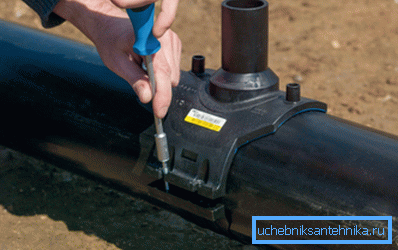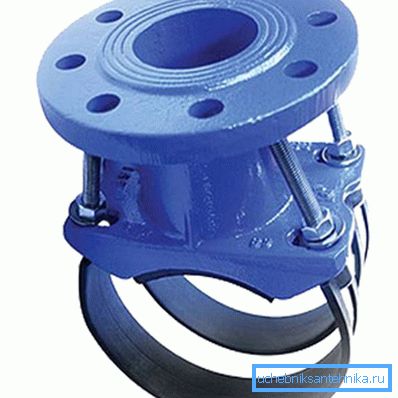Nurse on the polyethylene pipe: the main varieties,
In this article we will talk about how a saddle on a steel pipe differs from a similar device designed for installation on polyethylene. In addition, we consider the rules for the correct use of these devices for the intended purpose.

Main characteristics
The saddle retraction (saddle) is a part by means of which a secondary branch can be performed on the main pipeline. These devices are commonly used for efficient and reliable branching of water supply, sewage, irrigation, gas and other systems.
Structurally, the device is a kind of compression fitting and is represented by two main types: clamps and linings. Saddle removal is universal, as it is produced with different diameters for different types of pipes. If necessary, in most of the specialized stores you can purchase saddles for cast-iron, steel and plastic pipes.
Important: Many types of devices are designed for tapping into the pipeline under pressure, which greatly simplifies and reduces the cost of installation of water and sewer nodes.
Application features

The installation instruction for the saddle does not imply the integrity of the pipe. Most devices, for ease of use, are equipped with a special integrated cutter that allows you to quickly drill a hole in the pipe on which you are installing.
Among the advantages of using such devices, the following should be noted:
- the possibility of installation work in cramped conditions (in toilet and bathrooms, sewers, wells, mines, etc.);
- possibility of installation on the operated pipeline without the need to turn off the water supply;
- possibility of installation on any part of the system;
- possibility of use on systems with internal and external location;
- reasonable price, in comparison with the cost of installation of branches of other types;
- ease of installation without the need for special equipment.
Main varieties

In accordance with the design features of the nurse on a metal pipe is divided into the following categories:
- Modifications in the form of ferrules - mounted on the pipe, tightening from two sides with two curved halves. On one of the halves there is a threaded elbow in which the transitional part is placed for tapping into the pipeline.

Among the main characteristics of the device, we note the following:
- quick installation by simple bolting;
- optimum tightness of crimping due to the presence of a rubber sealing ring;
- possibility of installation on polyethylene, polypropylene, polyvinyl chloride and asbestos-cement pipes;
- possibility of use in sewage systems, water supply and irrigation;
- possibility of application in systems with a maximum temperature of the carrier +40? С;
- possibility of operation in systems with a maximum pressure of not more than 10 atmospheres;
- availability of devices designed for operation with pipes with a diameter of 2-31.5 cm.
- A saddle pad is a special device designed for installation on low pressure polyethylene pipes (HDPE). Such a device is mounted using electrodiffusion welding.

A saddle on a PND 110 pipe or on similar varieties, in the process of welding, is equipped with a heating element at the bottom - a spiral, to which a special welding machine is connected and the polymer pipes are heated to the temperature required for welding.
Important: Modern equipment for electrodiffusion welding can be programmed for one or another temperature conditions in accordance with a bar code printed on polyethylene pipes and fittings. This approach provides optimal protection of pipes against overheating and failure.
In the lower part of the saddle outlet there is a belt with the help of which the device is mounted on the required place just before welding.
After the belt is fixed at the required place and the plastic is heated to the required temperature, the welded parts of the saddle and the pipes are soldered to each other. Then, after some time, the cooling of the joint occurs, at the end of which a practically monolithic compound is formed.
This type of tie-in into the pipeline is characterized by the following qualities:
- the durability of the connection (up to the end of the service life of the pipe);
- optimum tightness of the connection and, as a consequence, the possibility of using on pipelines through which not only water but also gas;
- joint strength (weld joints withstand water pressure up to 16 atmospheres and gas pressure up to 10 atmospheres);
- the ability to perform insertion under pressure due to the presence of a special valve;
- simplicity and short deadlines for installation with the required quality results;
- accuracy of the finished result and, as a result, the possibility of using on domestic pipelines with internal arrangement.
Other varieties

In addition to these modifications, it is necessary to note this type of saddle branches, such as cast-iron flanged saddles, designed for installation on low-pressure polyethylene pipes (HDPE) with a cross-sectional diameter of 110-630 mm.
In fact, this device is a type of clamp, but somewhat different from the design of devices that are designed to work with metal pipes.
The main difference is that the fastener does not represent two one-dimensional parts. In this case, the main part is made flexible, and that it wraps around the pipe. The other is a smaller part of the device made of metal and equipped with a flange connecting element.
Conclusion
We considered the structural and operational features of the main types of saddle branches, which can be used on both domestic and large pipelines for various purposes. Instructions for the use of these devices with their own hands is simple, and therefore you will cope with this task yourself.
If you have any questions that require comprehensive answers, watch the video in this article.